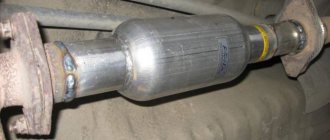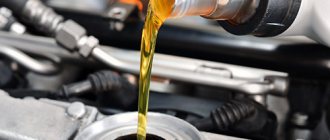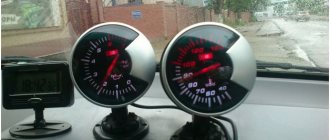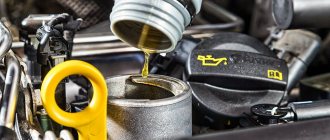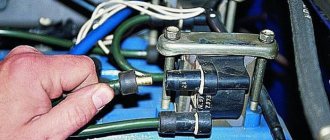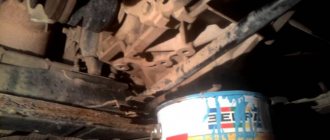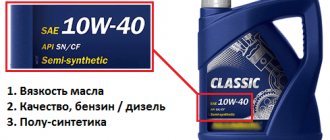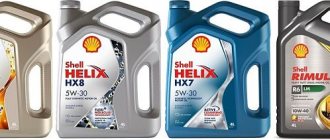A car engine is a very complex unit. It consists of hundreds of parts that are in constant interaction with each other. In order to extend the service life of all engine parts, prevent deformation as a result of excess friction, and avoid overheating of parts, special machine lubricant is used.
Every driver knows that it is necessary to regularly check the oil level under the hood and change it periodically. The more often this procedure is performed, the greater the chances of avoiding engine problems. An oil starved car can cause many problems.
Causes of engine oil starvation
Motorists call oil starvation the processes due to which some components of the power unit do not receive enough lubricant. Causes:
- Even in a completely serviceable new engine, some amount of lubricant is wasted. In worn drives, the volume of mixture lost to waste is much greater. Drivers who ignore checking the engine fluid level before leaving do not take into account: with each trip a certain amount of oil is lost, the mixture level gradually drops below about on the dipstick - this is critical for the engine.
- Untimely replacement of engine oil. As the mileage increases, the properties of the motor fluid change; the oil, for example, becomes thicker, stops penetrating into all components of the power unit, and “oil starvation” occurs.
- Using low-quality oil. If the engine fluid loses its original properties during operation of the power unit, this will lead to the absence of an oil film of sufficient thickness on the internal parts of the engine. The formed film will rupture as the load increases, and dry friction of the engine elements will occur. Use certified products from well-known brands.
We recommend: The most reliable and durable engines
How to determine oil starvation
It was immediately clear that the engine was “starved of oil”
First, let's talk about determining engine oil starvation, since the range of symptoms is quite wide - from a drop in engine power to overheating, extraneous noise and knocking. All this indicates wear of certain components characteristic of each engine. For example, in the most common overhead gasoline engines, accelerated wear and increased noise during operation of the gas distribution mechanism are often encountered.
Consequences
The consequences can be very different - jamming of the camshaft, bending of the camshaft, bending of the valves, destruction of the rocker arms, cranking of the crankshaft liners, jamming of the rings in the liner until the destruction of the pistons.
In addition, the oil scraper rings may become stuck, which will lead to even greater excess oil consumption and engine seizure. Thick blue smoke from the exhaust pipe will indicate a malfunction of the oil scraper rings and high oil consumption.
Features of engine operation without oil
The problem of lack of lubricant does not manifest itself until critical consequences occur. Knocks and squeaks that appear when the engine is running indicate a shortage or lack of oil in the engine and the need for an emergency stop.
Driving with insufficient lubrication may also result in blue smoke coming from the exhaust pipe or an exhaust smell coming from under the hood.
Causes of oil starvation
The main reason for early engine breakdowns is non-compliance with the rules of vehicle operation:
- Many drivers are lazy to monitor the oil level and add it on time. This may not immediately affect the condition of the engine. However, the longer its service life, the greater the likelihood of serious malfunctions. Absolutely every machine consumes oil lubrication. Therefore, even in a brand new car that has no complaints about its technical condition, it should be added sometimes. Some brands consume more oil, some less - in any case, you should not forget about replenishing the lubricant in the engine;
- Operation of old, used oil. Machine lubricant becomes thicker over time, so driving for a long time using old fluid is also fraught with great harm. Old oil stops being fluid and clogs the engine channels. In this case, the equipment loses the ability to work in normal mode, the parts are not lubricated and begin to break;
- Products of poor quality. A bad product that does not meet generally accepted standards can cause harm in any industry. Some time ago, cases of frequent breakdowns were already recorded due to the use of poor engine oil, which was produced by a fairly well-known brand. The reason lies in the fact that poor lubrication during operation turns into a thick mixture, which does not reduce, but even intensifies the process of friction of parts.
Causes of oil starvation
Engine operation in oil starvation mode is in almost all cases accompanied by increased temperature, which must be taken into account. In addition, the oil pressure in the system can be either very low (as indicated by the oil pressure warning lamp on the instrument panel) or unstable. All this can be caused by the following reasons:
- Insufficient oil level in the pan. There is simply not enough lubricant to process all the sliding bearings, there is no oil film, and the parts run almost dry. That is why it is important to check the engine oil level at least once a week, and even more often during active use. In addition, it is necessary to carefully monitor oil leaks and, if necessary, take measures to eliminate leaks.
Engine oil dipstick (analog on top, original on bottom). Incorrect dipstick readings may not promptly indicate to the car owner that the lubrication level is insufficient.
- Using oil of unsuitable viscosity . This is a very important point, since, for example, 5w-30 oil, when used in summer, may not provide the required viscosity, engine lubrication will be insufficient, and pressure at high temperatures may drop critically. To avoid this, you must follow the car manufacturer's recommendations when choosing motor oils.
- The oil receiver screen is clogged. The oil pump is not able to overcome the resistance of a clogged mesh, so oil cannot be supplied in the required quantity and under the required pressure to all components. The same applies to clogged oil lines. The ideal way out of this situation is to disassemble and mechanically clean the channels and oil receiver; flushing agents can only make things worse.
Oil pan clogged with dirt
- Irregular or untimely oil and filter changes. Each brand of oil has its own resource, which must be strictly observed. During operation, the lubricant loses most of its lubricating properties and by the end of its service life it can be almost completely oxidized and lose viscosity.
Disassembling the oil filter
- Wear of oil scraper rings and increased oil consumption . Wear of valve stem seals and crankshaft seals will also lead to high oil consumption.
- Poor quality engine assembly after repair . A competent motor mechanic will never use sealant where a simple gasket is enough - the fact is that excess sealant is pressed not only outward, but also into the oil channels, clogging them over time.
- Failure or clogging of the lubrication system pressure reducing valve.
- Oil filter clogged.
We recommend: 18 best motor oils
What happens if you drive without oil in the engine?
Is it possible to drive a car when there is no oil in the engine?
Engine oil lubricates all moving parts to reduce friction and prevent rapid wear. So, will the engine run without oil?
Driving a car when there is no oil in the engine will definitely lead to instant wear of any engine parts. At low speeds, if you are very lucky, you may be able to drive without noticeable consequences, especially if the engine is new, but most likely you will soon hear a knock or squeak from under the hood. This will mean that the crankshaft journal has begun to come into contact with the bearings. Further, if you do not stop in time, the engine may simply jam and require major repairs.
Also, a knocking sound may mean that the engine bearings have rotated. In any case, it is not recommended to continue driving and you should immediately contact service for help. And then you might be able to get away with relatively inexpensive repairs.
Typically, when the oil level drops below the recommended level, the oil pressure error light comes on. In this case, you must stop driving and add oil to the engine.
To keep the engine in good condition and in good condition, it is recommended to check the oil level at least once a month, or better yet every two weeks, and top up if necessary.
This procedure will not take much time, but will save a large amount of money, time and nerves.
Get your car serviced and diagnosed more often, so your car will serve you for a long time and without problems.
Source
Does the motor run without lubricant?
On advertising stands, there are cars whose drives operate without oil, the pan is completely removed. This situation is of interest; because of it, drivers believe that a low level of engine fluid in the system is not a problem. This opinion is wrong. The operating mode of the machine on the advertising stand differs from the actual operating conditions of the power unit:
- The engine runs at idle speed; it requires a protective oil film that is much thinner than under real operating conditions of the power unit.
- No exposure to high temperatures. Under real conditions, the piston group is exposed to high temperatures, without proper lubrication, abrasion of the internal drive elements occurs. The exhibition engine can withstand long periods of time without lubrication due to ventilation and lack of exposure to high temperatures.
- Before starting the experiment, the engine parts are thoroughly polished - the friction force is reduced, the machine operates for a long time without lubricant.
Is it possible to drive without oil?
And yet, how long can you drive a car without oil in the engine? No one would want to do this experiment on their car. Everyone already knows what this means, at least costly repairs, or even replacement of the engine. But similar experiments were carried out, this is how the Mercedes C180 was tested. The oil was completely drained from it, and we went to the race track. He worked for only 17 minutes, but at the limit of his capabilities.
Perhaps under normal conditions he would have worked a little longer. The motor died due to overheating, the rubbing elements of the crank mechanism were not cooled in any way, as the temperature increased, the gaps decreased, the parts rubbed dry, scuffs formed and the engine jammed. To avoid such a situation, look under the hood more often, check the engine for oil leaks, and keep the level sufficient, since oil sometimes goes to waste.
Experience shows that in a critical situation you can drive for some distance with a low level or no oil in the engine. But in the future, it is imperative to find the cause of the oil leak and make repairs. Long-term operation of a dry engine is impossible.
What do you think - can an engine run without oil? What will happen to him? Will it knock right away or will it work a little longer? Let's say you have a hole in your oil pan. What should you do?
Drive further or tow the car? If you start looking for information about this on the Internet, the first thing you will see is advertisements for various additives. Whether it's a supprotec or an amp auto.
It should be said right away that the engine with these additives will work, but only at idle speed. At the Suprotec stands and other things, the engines are specially prepared. All rubbing parts in it are liners, rings are adjusted with perfect compatibility.
